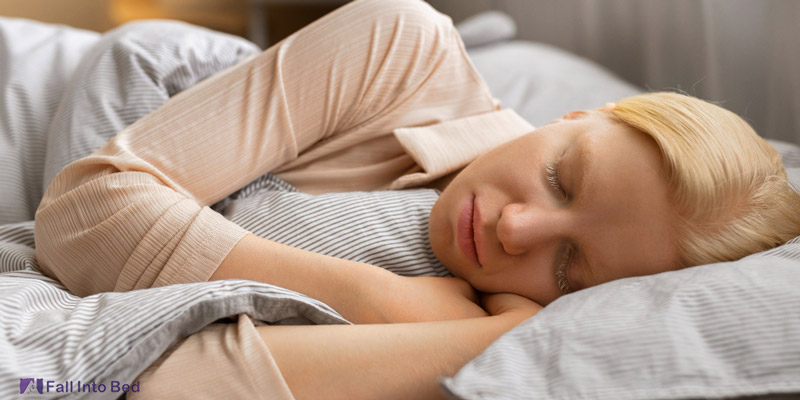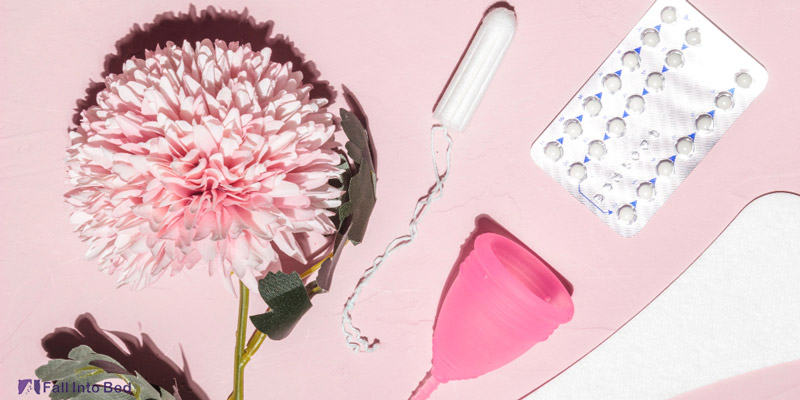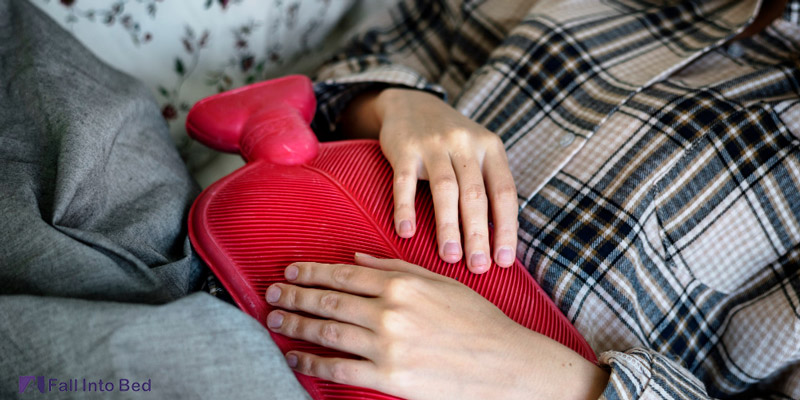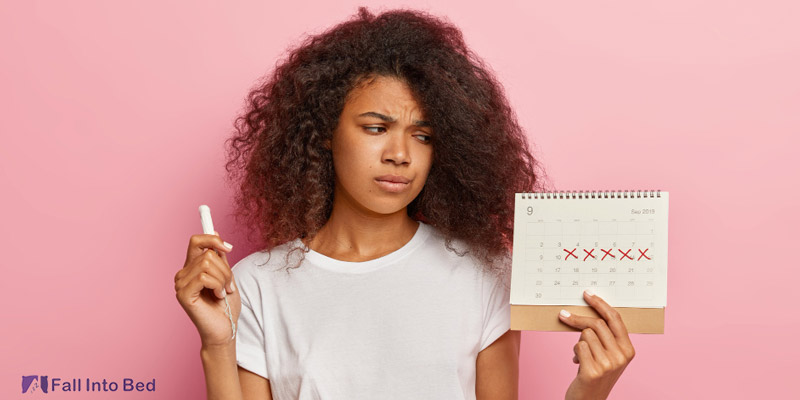There is no denying in the fact that periods are painful and uncomfortable. Especially when it comes to sleeping, all the discomfort gets doubled. We have to worry about leakage, pain, cramps, bloating and god knows what. But worry no more ladies, in this article we’re going to talk about best sleep positions during periods to avoid leakage and reduce cramps and pain. We’re also going to talk about how we can have a more comfortable sleep despite the temporary situation we have to deal with.
Why am I Tired on My Periods?
Feeling tired during your period is a common experience, and it can happen for several reasons:
Hormonal changes, particularly the drop in estrogen, can leave you feeling low on energy. Additionally, blood loss during menstruation can lead to a decrease in iron levels, causing fatigue, especially if you’re already prone to iron deficiency.
Sleep may also be disrupted by cramps, bloating, or mood swings, which contributes to feeling more tired. Hormonal fluctuations can lower serotonin levels, affecting your mood and energy. On top of all this, your body is working hard to shed the uterine lining, which can feel physically draining.
To combat period fatigue, staying hydrated, eating iron-rich foods, getting enough rest, and doing light exercise can help restore your energy levels.

Common sleep problems during menstruation
Before we get in to the detail of how to sleep during periods, let’s have a look at common problems that can occur during the night in menstruation:
- Cramps: Menstrual cramps can make it really tough to get comfortable. The constant cramping can disrupt your ability to find a good sleeping position, leaving you tossing and turning throughout the night.
- Bloating: Hormonal changes can cause bloating, which feels like your stomach is overly full or swollen. This can make lying down feel uncomfortable and disrupt your sleep.
- Blood leakage: Even with the most absorbent pads or tampons, the fear of leakage can cause anxiety, making it difficult to relax and fall asleep. This worry might keep you up, or you might wake up in the middle of the night to check or change your protection.
- Back pain: Lower back pain from menstruation can be particularly disruptive. It can make finding a comfortable sleeping position challenging and cause you to wake up frequently due to discomfort or pain.
Best sleep positions for menstrual cramps
Foetal position
The best sleeping position during period, is foetal position. This position refers to sleeping on your side with your knees bent towards your chest.
Sleeping in this position can ease the pain and avoid leakage since sleeping on the side reduces pressure on the abdominal muscles. Also, many people experience lower back pain during their period, and the fetal position helps keep the spine aligned and eases pressure on the lower back.
And curling up in this position helps keep the legs together, which can reduce the risk of leakage at night.
Check out the differences between sleeping on the left and right side of the body, to make sure you don’t elevate other symptoms of conditions.

Sleeping on the back
If sleeping on the side Lying on your back reduces pressure on the uterus and can potentially reduce cramps. However, this position is believed to increase leakage during the night, especially if you have a heavy flow.
Also, if you have breathing problems during sleep, sleeping on the back can’t be an ideal position.
Comparing sleep positions during periods that avoid leakage
Side sleeping
As we mentioned in the foetal sleep position, sleeping on the side can reduce the chances of leakage during your periods. This position, with your legs bent, keeps the legs together and doesn’t let the blood to leak.
Elevate your legs
If you want to sleep on your back, but you’re afraid of waking up to see blood stains on your clothes and sheet, elevating your legs can help you with that. In this position, you can sleep on your back and place a pillow under your knees or legs.
Also, keep on mind that using menstrual cups offers a better protection when it comes to preventing leakage.
Stomach sleeping
This position is one of those positions that you should avoid during your periods at all costs. Sleeping on the stomach increases the pressure on the abdominal muscles and the uterus, and worsens cramps and pain.
And since you’re lying flat against the mattress, this position may increase the chance of menstrual leakage, especially if your flow is heavy.
overview table of sleep positions during periods
| Sleep position | helpful with cramps | helpful with leakage |
|---|---|---|
| Side sleeping – foetal | ✔️ | ✔️ |
| Sleeping on the back | ✔️ | ❌ |
| Stomach sleeping | ❌ | ❌ |
Which one is safer to sleep with during periods, pads, tampons or cups?
When it comes to preventing leakage at night, menstrual cups are usually the most effective choice. They can hold a lot more fluid than pads or tampons, which helps reduce the risk of leaks. The cup fits snugly inside, creating a seal that keeps everything contained, though it’s important to make sure it’s positioned correctly.
Overnight pads designed for heavy flow are also a solid option. They offer extra coverage and absorbency to catch any leaks, but they can sometimes shift if you move around a lot while sleeping.
Tampons can help too, but they might need to be changed more frequently to avoid leaks, and they don’t offer as much protection as cups or pads for heavier flows. Also, you should make sure you change your tampons evert 4-8 hours. Leaving a tampon in for more than 8 hours, increases the risk of Toxic Shock Syndrome (TSS) and infections.
So, if you’re looking for reliable protection, menstrual cups or high-quality overnight pads are generally your best bets.

Comfort tips for sleep during your periods
Take over-the-counter painkillers
I know that some of us like to test our pain tolerance to see how long we can handle it, but there’s really no need to suffer when relief is just a pill away! Over-the-counter painkillers for periods like ibuprofen (Advil, Motrin) or naproxen (Aleve) can be your best allies in fighting menstrual cramps and discomfort. They tackle pain and inflammation so you can go about your day without feeling like you’re wrestling a bear.
Acetaminophen (Tylenol) can also help with pain, though it doesn’t quite tackle inflammation. Just remember to follow the dosage instructions—no need for any over-the-top heroics! Taking them with food can help prevent any stomach grumbles, and if you have other health concerns, it’s a smart move to check in with your healthcare provider. So, go ahead and take that relief, you’ve earned it!
Do yoga
Yoga can be a surprisingly effective remedy for pain, including menstrual cramps and lower back discomfort. Think of it as your body’s way of doing a little happy dance to ease the ache. According to Healthline, here are a few poses that might just do the trick:
- Child’s Pose: This one’s like giving your lower back a cozy hug. Kneel, sit back on your heels, stretch your arms forward, and let your forehead rest on the floor.
- Cat-Cow Stretch: This dynamic duo stretches your spine and abs while making you look like a playful kitten and a content cow. Just alternate between arching your back (meow) and dipping your belly (moo).
- Legs Up the Wall: Lie on your back and let your legs enjoy a vertical holiday against the wall. This position boosts circulation and helps reduce that bloated feeling.
- Seated Forward Bend: Sit with your legs stretched out and reach for your feet. It’s a nice stretch for your hamstrings and lower back.
- Supine Twist: Lie on your back, bend one knee, and let it cross over your body while keeping your shoulders grounded.
Just remember to listen to your body and avoid any poses that feel like they’re putting you in a pretzel. If you’re new to yoga or have specific health concerns, a yoga instructor or healthcare provider might have some personalized tips to keep your practice safe and soothing.
Use heating pad
If you experience cramps or lower back pain during the day or night, using a warm water bottle or heat wrap can work wonders for relief. It can help relax muscles, increase blood flow, ease cramps and bloating.

Keep your bedroom cool
Feeling hot during your period is usually due to hormonal changes that affect your body temperature. Increased blood flow and changes in how your body regulates heat can also make you feel warmer.
To stay comfortable, try drinking plenty of water, wearing light clothing, and using a fan or air conditioning. If the heat feels intense or persistent, it’s a good idea to talk to a healthcare provider for advice.
Use more than one protection against leakage
If you experience heavy flows and always worried about leaking during the night, you can try using more than one way to prevent the leakage. For example, you can try putting a menstrual cup and a pad. This way, you can relax, that even if my cup leaks, the pad can prevent it from making a mess.
FAQ about sleep during periods
1. Can I sleep on my stomach during my periods?
Sleeping on the stomach is possible. But you should know that this position puts a lot of pressure on your abdomen and uterus that can lead to increased cramps. Also, you’re more likely to leak in this sleep position.
2. What’s the best position to sleep in during my periods?
While the best position really depends on your comfort and flow, many women prefer sleeping on their side in a fetal position as it reduces pain and chance of leakage.
3. How can I prevent leakage while sleeping?
Sleeping on the side can prevent leakage. Also, it’s said that menstrual cups do a good job at preventing leakage from happening. You can use pads and cups at the same time, just to be sure that nothing happens during your sleep.
4. Is it safe to use tampons overnight?
Yes, It is safe to use tampons. However, you should make sure you change the tampon every few hours to prevent leakage and reduce the risk of toxic shock syndrome.
5. Can I wear period underwear to sleep?
Yes, period underwear is a great option for overnight use. They’re designed to be absorbent and can provide reliable protection against leaks. They’re also comfortable and don’t shift during the night.
6. How often should I change my menstrual protection at night?
It depends on your flow and the type of product you’re using. Generally, it’s a good idea to change pads or tampons every 4-6 hours. Menstrual cups can typically be worn for up to 12 hours, but you might want to empty it before bed if you have a heavy flow.








